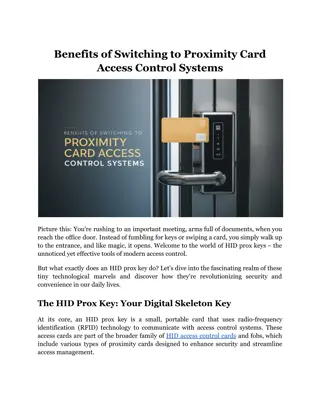
How to Choose the Right proximity Card Supplier for Your Needs
Find the best proximity card supplier with these tips. Ensure quality, reliability, and security for your business needs.n
Download Presentation

Please find below an Image/Link to download the presentation.
The content on the website is provided AS IS for your information and personal use only. It may not be sold, licensed, or shared on other websites without obtaining consent from the author. Download presentation by click this link. If you encounter any issues during the download, it is possible that the publisher has removed the file from their server.
E N D
Presentation Transcript
How to Choose the Right Proximity Card Supplier for Your Needs? Selecting the right proximity card supplier for your organization's access control needs is a critical decision that can impact security, efficiency, and long-term costs. Proximity cards have become a staple in modern access control systems, offering a convenient and secure method for managing entry to buildings, restricted areas, and even digital resources. These cards utilize radio frequency identification (RFID) technology to communicate with card readers, allowing for quick and contactless authentication. The market for proximity cards is diverse, with numerous suppliers offering a range of products, from basic 125 Khz proximity cards to more advanced options with enhanced security features. Each supplier brings its own strengths, specialties, and product lines to the table. Some focus on providing cost-effective solutions for small businesses, while others cater to large enterprises with complex security needs. Understanding your organization's specific requirements and how they align with different suppliers' offerings is crucial in making an informed decision.
How to Choose the Right Proximity Card Supplier for Your Needs? Assess Your Organization's Needs It s essential to have a clear understanding of your organization's specific requirements. Consider the following points: Scale of deployment: How many cards will you need initially and in the future? Security level: What level of security is necessary for your facility? Integration: Does the system need to integrate with existing software or hardware? Budget: What is your allocated budget for this project? Future scalability: How might your needs evolve in the coming years? Know the Types of Proximity Cards Understanding the different types of proximity cards available can help you narrow down your options: HID prox cards: A popular choice known for reliability and wide compatibility. HID proxcard 2: An advanced version with enhanced security features. Prox card II HID: Often used in high-security environments. 26 bit proximity cards: A standard format widely used in access control systems. Low-frequency cards: Typically operating at 125 kHz. High-frequency cards: Usually at 13.56 MHz, offering more security and data capacity. Read More Articles: HID Proximity Cards: Customization Options for Enhanced Functionality Evaluating Supplier Reliability Choosing a reliable supplier is crucial for ensuring a smooth implementation and ongoing support. Consider these factors: Industry reputation: Research the supplier's standing in the industry. Customer reviews: Look for feedback from other organizations similar to yours.
Years in business: Longevity can be an indicator of stability and expertise. Financial stability: Ensure the supplier is financially sound to support long-term needs. Bristol ID Technologies has been a trusted name in the proximity card industry for over two decades, serving clients across various sectors. Quality and Durability The quality and durability of proximity cards directly impact their lifespan and reliability. Look for suppliers that: Use high-grade materials resistant to wear and tear. Offer cards with protection against environmental factors like moisture and temperature fluctuations. Provide clear specifications on card lifespan and usage conditions. Have quality control processes in place to ensure consistent product quality. When considering durability, the HID prox card 2 is known for its robust construction and longevity, making it a popular choice for organizations that require cards to withstand frequent use and varying environmental conditions. Compatibility and Standards Compliance Ensure that the supplier's cards are compatible with your existing or planned systems: Check if the cards work with your current or intended card readers. Verify compliance with industry standards like ISO/IEC 14443 for contactless smart cards. Consider suppliers that offer cards compatible with multiple systems for future flexibility. Security Features Security is paramount when it comes to access control, especially when you re planning to purchase HID proxcard 2. Evaluate suppliers based on the security features they offer: Encryption capabilities to prevent unauthorized cloning or reading of card data. Anti-tampering measures to detect any attempts to modify the card. Option for custom security features like holograms or special printing.
Customization Options Many organizations require customized cards to fit their branding or specific needs. The prox card II HID is an excellent choice for organizations requiring high-level security features, as it offers advanced encryption and anti-cloning technology. Look for suppliers offering a range of customization options, including: Custom printing and graphics Various card sizes and thicknesses Special features like magnetic stripes or smart chip integration Production Capacity and Lead Times Consider the supplier's ability to meet your volume requirements and delivery timelines: Assess their production capacity, especially for large orders. Inquire about typical lead times for both standard and customized orders. Check if they offer expedited production options for urgent needs. Comparison of Common Proximity Card Types Card Type Frequency Read Range Security Level Typical Applications HID card 2 prox 125 kHz Up to 6 inches Medium Office buildings, Schools 26 proximity cards bit 125 kHz 2-4 inches Medium Small medium businesses to Prox card II HID 125 kHz Up to 8 inches High Government facilities, Healthcare High-freque ncy cards 13.56 MHz 1-3 inches Very High Financial institutions, High-security areas
Technical Support and Customer Service The level of support provided by a supplier can significantly impact your experience: Evaluate the supplier's technical support capabilities. Check if they offer training for system setup and management. Look for suppliers with responsive customer service teams. Consider the availability of online resources, documentation, and troubleshooting guides. Pricing and Cost Considerations While price shouldn't be the only factor, it's an important consideration. You should compare pricing across multiple suppliers for similar products and look beyond just the card cost consider factors like: Bulk order discounts Customization costs Shipping and handling fees Any ongoing support or maintenance costs Environmental Considerations For organizations with sustainability goals, consider suppliers that offer eco-friendly options: Look for cards made from recycled or biodegradable materials. Check if the supplier has environmentally conscious manufacturing processes. Inquire about card recycling programs or end-of-life disposal options. When evaluating costs, remember that while 125 Khz proximity cards may be more budget-friendly initially, they might not offer the same level of security as higher-frequency options. Balance your budget with your security needs to find the best solution. Read More Articles: Common Mistakes to Avoid During Bathroom Floor Tile Removal Innovation and Future-Proofing The access control industry is constantly evolving. Choose a supplier that:
Invests in research and development. Regularly update their product lines with new technologies. Offers migration paths to newer technologies as they become available. Contract Terms and Warranties Carefully review the supplier's contract terms and warranty offerings: Understand the warranty coverage and duration. Look for flexibility in contract terms, especially for long-term agreements. Check for any hidden fees or clauses that might impact your total cost of ownership. Sample Testing Before committing to a large order, consider requesting samples: Test the cards with your existing or planned systems. Evaluate the print quality and durability in real-world conditions. Use this opportunity to assess the supplier's responsiveness and support. Wrapping Up Selecting the ideal proximity card supplier is a pivotal decision that can significantly influence your organization's security infrastructure and operational efficiency. The journey to finding the right partner involves a comprehensive evaluation of various factors. Investing time in this selection process pays dividends in the form of a robust, reliable, and future-proof access control system. Consider the full spectrum of what each supplier brings to the table - their product range, technical expertise, industry reputation, and commitment to customer satisfaction. Bristol ID Technologies stands out as a premier provider of proximity card solutions, offering a comprehensive range of high-quality cards and customization options. Our commitment to innovation and security makes us an ideal partner for organizations looking to implement or upgrade their proximity card systems. We are famous for our seamless blend of novel technology, superior quality, and unmatched service in the world of access control solutions, ranging from 26 bit proximity cards to HID prox cards. Site Article: How to Choose the Right proximity Card Supplier for Your Needs?






















